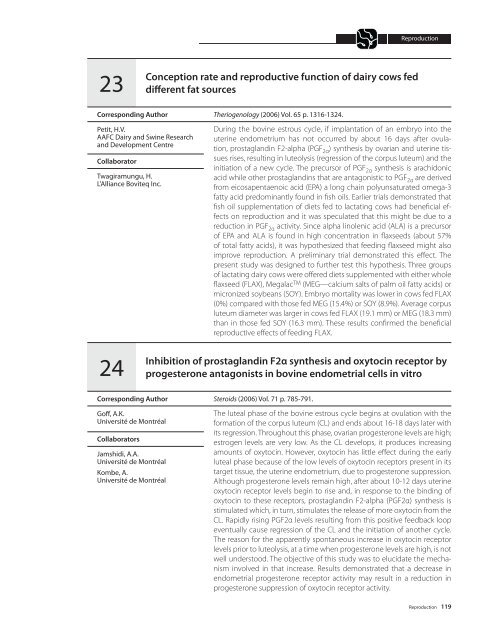A52-75-2007E.pdf - AgroMedia International Inc
A52-75-2007E.pdf - AgroMedia International Inc
A52-75-2007E.pdf - AgroMedia International Inc
You also want an ePaper? Increase the reach of your titles
YUMPU automatically turns print PDFs into web optimized ePapers that Google loves.
Reproduction23Conception rate and reproductive function of dairy cows feddifferent fat sourcesCorresponding AuthorPetit, H.V.AAFC Dairy and Swine Researchand Development CentreCollaboratorTwagiramungu, H.L’Alliance Boviteq <strong>Inc</strong>.Theriogenology (2006) Vol. 65 p. 1316-1324.During the bovine estrous cycle, if implantation of an embryo into theuterine endometrium has not occurred by about 16 days after ovulation,prostaglandin F2-alpha (PGF 2α ) synthesis by ovarian and uterine tissuesrises, resulting in luteolysis (regression of the corpus luteum) and theinitiation of a new cycle. The precursor of PGF 2α synthesis is arachidonicacid while other prostaglandins that are antagonistic to PGF 2α are derivedfrom eicosapentaenoic acid (EPA) a long chain polyunsaturated omega-3fatty acid predominantly found in fish oils. Earlier trials demonstrated thatfish oil supplementation of diets fed to lactating cows had beneficial effectson reproduction and it was speculated that this might be due to areduction in PGF 2α activity. Since alpha linolenic acid (ALA) is a precursorof EPA and ALA is found in high concentration in flaxseeds (about 57%of total fatty acids), it was hypothesized that feeding flaxseed might alsoimprove reproduction. A preliminary trial demonstrated this effect. Thepresent study was designed to further test this hypothesis. Three groupsof lactating dairy cows were offered diets supplemented with either wholeflaxseed (FLAX), Megalac TM (MEG—calcium salts of palm oil fatty acids) ormicronized soybeans (SOY). Embryo mortality was lower in cows fed FLAX(0%) compared with those fed MEG (15.4%) or SOY (8.9%). Average corpusluteum diameter was larger in cows fed FLAX (19.1 mm) or MEG (18.3 mm)than in those fed SOY (16.3 mm). These results confirmed the beneficialreproductive effects of feeding FLAX.24Inhibition of prostaglandin F2α synthesis and oxytocin receptor byprogesterone antagonists in bovine endometrial cells in vitroCorresponding AuthorGoff, A.K.Université de MontréalCollaboratorsJamshidi, A.A.Université de MontréalKombe, A.Université de MontréalSteroids (2006) Vol. 71 p. 785-791.The luteal phase of the bovine estrous cycle begins at ovulation with theformation of the corpus luteum (CL) and ends about 16-18 days later withits regression. Throughout this phase, ovarian progesterone levels are high;estrogen levels are very low. As the CL develops, it produces increasingamounts of oxytocin. However, oxytocin has little effect during the earlyluteal phase because of the low levels of oxytocin receptors present in itstarget tissue, the uterine endometrium, due to progesterone suppression.Although progesterone levels remain high, after about 10-12 days uterineoxytocin receptor levels begin to rise and, in response to the binding ofoxytocin to these receptors, prostaglandin F2-alpha (PGF2α) synthesis isstimulated which, in turn, stimulates the release of more oxytocin from theCL. Rapidly rising PGF2α levels resulting from this positive feedback loopeventually cause regression of the CL and the initiation of another cycle.The reason for the apparently spontaneous increase in oxytocin receptorlevels prior to luteolysis, at a time when progesterone levels are high, is notwell understood. The objective of this study was to elucidate the mechanisminvolved in that increase. Results demonstrated that a decrease inendometrial progesterone receptor activity may result in a reduction inprogesterone suppression of oxytocin receptor activity.Reproduction 119





